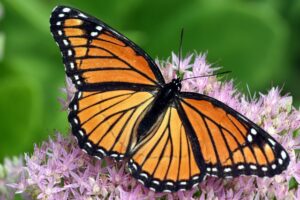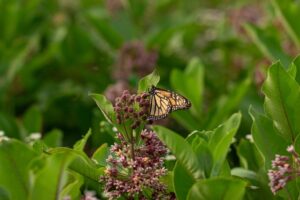
Were you aware that monarch butterflies are dwindling in population? According to the South Carolina Wildlife Federation (SCWF), the population of brilliant orange-hued butterflies have seen a decline of 97% across the past 2 decades. The drastic drop in population numbers has local Upstate researchers concerned, and looking into ways our area residents can help reverse this trend.
Less Milkweed Plants Are Causing Loss of Food, Habitat.
Do you know butterflies need mainly one plant to survive? Yes, that’s true! The plant, called milkweed, is an essential part of a monarch’s habitat, crucial to their survival. Milkweed can be found from tropical regions of Mexico up north to Canada. And while the plant can survive in many plant zones, it is becoming increasingly sparse. But why is this so important to butterflies?
Monarch butterflies utilize the milkweed plant for nourishment and as a safe haven or habitat in which to lay their eggs. In fact, it is the only food that monarch caterpillars will eat once hatched. According to wildlife.org, milkweed started rapidly disappearing in the 1990s as farms & homeowners started using more herbicides. This is especially true in some regions in the US, such as the Midwest, where farmland has expanded, causing large gaps in the natural coverage of milkweed, leading to less mating and migration of monarchs.
In fact, to feed just one adult monarch butterfly, multiple milkweed plants are needed. That’s a lot of milkweed needed!
How can we help the monarch butterfly population grow?
Monarchs aren’t all alone – we can help the butterflies start to bounce back with simple garden planning! While milkweeds used to be a native plant to grasslands and meadows, many gardeners and avid butterfly enthusiasts are getting smart to the importance of milkweed, and starting to incorporate it more in their gardens. If you’re interested in adding the plant to your garden or landscaping, here are some tips for gardening with milkweed:
- First, there are 3 main types of milkweed you’ll want to look for and it’s important to know which kind you’re planting. According to Garden Design, there are some variations which can be quite invasive, so planting them in a bed with other flowers and plants can cause crowding and eventually kill the other plants. To make sure you are choosing a good variety, they recommend the common milkweed, swamp milkweed, and butterfly milkweed. The common milkweed should be avoided if blending with other plants as it is the aggressive form.
- Milkweed feature beautiful small flowers that cluster on long stems, and will sometimes show a white sap on their leaves when the leaves are cut. This appearance is what gave the plant its name.
- The plant can grow to 2-5 feet in height and is pretty hardy. Upstate South Carolina is a perfect region for growing the plant, being safely within hardiness zones 7a-8a. Milkweed can grow easily in zones 3-9.
- Look for a sunny spot in your yard. The plant favors full sun and in a spot that can take on a larger spread of the plants, as they will quickly multiply if under favorable conditions. Your soil quality is not likely to matter very much, since the butterfly kind can typically tolerate average garden soil in our area.

For a limited time, you may be able to get free milkweed seeds!
If you are a South Carolina resident, you can click here to request your free packet of seeds from the SCWF to plant and help your area see more of these colorful and bright little fliers.
Not a South Carolina resident? You can still go to your local nursery and request native milkweed seeds to plant in your community or area. Smart Seeds Emporium is a popular seller of these seeds and can answer any questions you may have about planting milkweed in your garden or lawn.
Be an active participant of your local ecosystem.
We are blessed to call the Upstate our home, with its vast variety of plants and animals. The Appalachian Mountain range is home to some of the most unique & diverse flora species in the world, and this includes the milkweed. We encourage everyone that calls Lake Keowee or greater Upstate South Carolina their home to help take care of our natural surroundings, and this includes the monarch butterfly. By planting a few plants each year, you can be a part of the outpouring of support for these little creatures, helping them make a comeback. Let’s help them rebound and populate so that not only our children, but generations to come may be able to enjoy their brilliant splendor.

Recent Comments